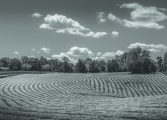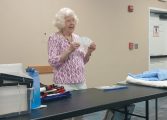By Page H. Gifford
Correspondent
At the monthly meeting of the Fluvanna Art Association on July 18, Fluvanna High School art teacher Michael Morris talked about his journey as an artist and teacher. A native of Fluvanna, he grew up on Quaint Lea Farm in Palmyra and recalls his fascination with nature, the animals, and the farm structures, particularly “the dilapidated ones.”
“Our house was full of paintings, prints, watercolors, oils, and different styles, even some that my mother brought back from Spain when she traveled there.” He said his favorite place was outdoors. There, he was surrounded by all kinds of odds and ends of various farming eras, from rusty implements to weathered wood. His mother painted and was fond of birds, and his grandfather also dabbled in painting but preferred woodworking. These influences shaped Morris’s artistic interest.
His grandfather lived in Bremo Bluff, built the Bremo Power Plant, and later became its operations manager.
During high school and college, Morris discovered many facets of his artistic self. Recognizing his inner perfectionist as he overworked his pieces, he learned to loosen his style. He has experimented with many different styles and mediums.
“I would read comic books, mostly for the imagery, and it helped me to draw the human figure in different poses.” He attended Bridgewater College, where he majored in studio art. His favorite subjects were printing, etchings, lithographs, and sculpture. One of his projects used parts of his Honda car. In a black and white print, using negative space, he created a collage of car parts and used the actual pieces to create sculptures.
“Sculpture is more permanent,” he added. During the time he began building his art career, he lived in Bristol when a tornado destroyed his house. Being the creative type, he dealt with the loss and devastation of his home, which had been boarded up, by painting murals on the boarded-up windows and doors. He had a crying eye on one window, a smile on another, and a bulldog on the door. The symbolism he left behind spoke about hope and gratitude.
He reiterated through a series of pictures of his work that anything available can be used , from car parts, a fishing reel, to cow skulls, to make art. From seeing his work, it is evident that he his astute at looking at an object and completing a sculpture, print, a mural, watercolor, or an acrylic painting. His work is diverse and fearless. He’s not afraid to turn something mundane into something meaningful.
“My students are afraid to try anything new, but if you don’t try, you’ll never know,” he said. “I encourage my students to think outside the box and use different materials.”




